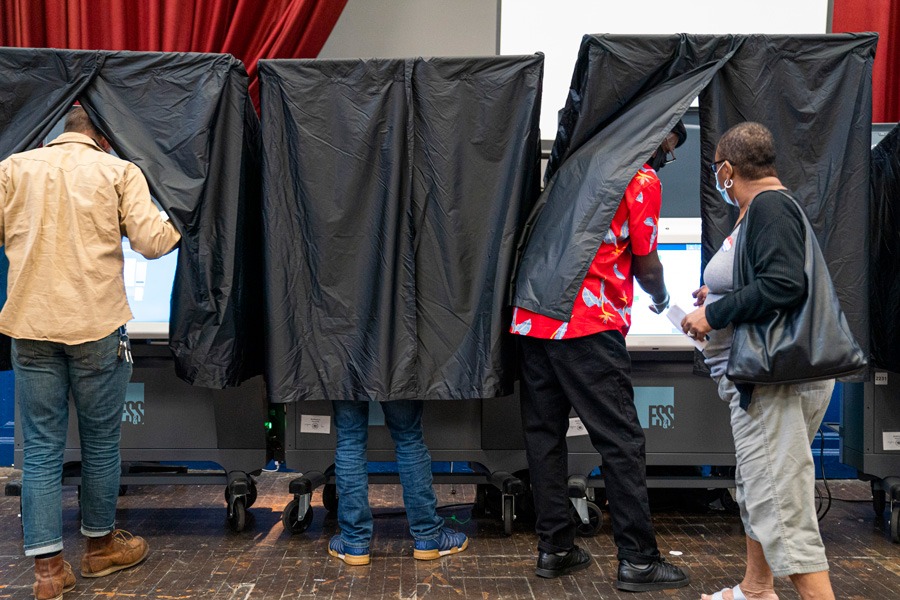Here Are All the Ways You Can Cast Your Ballot in the General Election
A pandemic is not an excuse to skip voting. These are the five options — including by mail and in person methods — that you have to get your ballot in.

Trying to make a general election voting plan? Here are your options. Photograph by
Jessica Kourkounis / Stringer via Getty Images
The June primary — our first election attempt under pandemic conditions and with a massive increase in mail-in voting — may not have been a total disaster, but that likely had something to do with the fact that there were just 348,470 voters here in Philadelphia County. City Commissioner Al Schmidt expects more than 650,000 will vote in Philadelphia in November, either by mail or in person. That’s 301,530 more people having to learn how to use new voting machines or navigate the vote-by-mail process.
“We have relatively new voting machines,” says Schmidt. “We have new election laws. We have a COVID-19 environment complicating things. And it’s all during a presidential election year.”
It’s important to vote in whichever way you are most comfortable. Below, we’ve illuminated and dissected every possible method you have to cast your ballot.
Before attempting to vote in any capacity, confirm that you’re registered to vote. You can check your registration status with just your name, county, zip code and date-of-birth. Those who are not registered to vote in the state of Pennsylvania can register online or download and mail a registration form by October 19th.
Mail-In Voting
As of the June primary, Pennsylvania has allowed “no-excuse absentee voting.” Which simply means that, thanks to the still-raging pandemic, anyone can request a mail-in ballot. So far, more than 250,000 Philadelphians have requested their mail-in ballots. If you’re one of the stragglers, the good news is the internet has made it impossibly easy to get started. Too lazy to Google “pa mail-in ballot”? Instagram will feed you ads from innumerable organizations with convenient links. Facebook has an entire “Voting Information Center,” with links to register, request ballots and volunteer to work the polls. It even aggregates posts from your local election officials. It has literally never been simpler. All you need to do is click here and have your Pennsylvania driver’s license handy. This writer spent two and a half minutes on the application, not counting the 10 seconds it took to retrieve her license from the bottom of her purse.
Don’t have a PA license or PennDOT ID? It’s a little more complicated, but still easy enough: You’ll have to download and mail in a paper form (find them here). Your application, whether online or paper, must be received by your county’s election office by 5 p.m. on October 27th, so if you’re mailing in a request, do it A.S.A.P. (Seriously: Don’t wait until the last minute. As you’ll see below, even meeting the October 27th deadline may still be too late.)
The county elections office is hard at work processing mail-in ballot requests as they come through. You can expect your application to be processed within a few days. Naturally, those submitted online are processed and approved at a faster clip than those submitted on paper. (The writer’s own request was approved in less than 24 hours.) The election office originally expected to begin mailing out ballots on September 14th, but because a ballot dispute with the Green Party was just settled in court on Thursday, printing can only begin in earnest starting today. Philly voters who have already requested ballots should receive them in the mail within eight to 10 days, according to the City Commissioners Office.
Once those ballots are certified and printed, the closer to election day, the tighter your window becomes. Yes, you technically have until October 27th to get that application in, but says Schmidt, that deadline is “totally unrealistic.”
“Even if you apply, and we can turn that ballot around in a day or two at the most and get it out, you would still have to get it in the mail from us, fill it out, and mail it back to us.”
This particular hurdle was the biggest problem in the June primary. The Inquirer found that of ballot request applications that were processed within three weeks of election, only 76 percent were returned. Of those who requested their ballots more than three weeks in advance, 90 percent eventually voted. Long story short: request your ballot right this very second.
Method #1: Stick it in the mail
After you have 1.) received your ballot, filled in the bubbles alongside the candidates of your choice (in blue or black ink, no X’s or check marks, please!), 2.) sealed the ballot in the envelope that ensures your anonymity, 3.) put that envelope in the larger return envelope, and 4.) signed and completed the voter’s declaration, you have multiple ways to mail that ballot back to your county’s election office.
Bring your completed ballot to a post office, drop it in a street letterbox, or stick it in your own mailbox with the flag upright. Thanks to a recent state law, all return envelopes will include first class postage, so you can be confident USPS will prioritize your mail. J.J. Abbott, executive director of Commonwealth Communications and Tom Wolf’s former press secretary, recommends mailing your completed ballot at least two weeks prior to election day. Thanks to a recent Pennsylvania Supreme Court decision, the county commissioner’s office can now accept ballots through 5 p.m. on the Friday after election day. We recommend aiming to get yours in by 8 p.m. on November 3rd, though.
The state also provides a ballot tracking software. With just your name, date of birth and county, the tracker will tell you the status of your ballot application, when your ballot has been sent out, and, once you return it, when your commissioner’s office has received it.
Though the United States Postal Service has been experiencing delays, both Schmidt and Abbott say it is unlikely to impact vote-by-mail. Says Abbott, “There have been some issues with the postal service, but at this point it doesn’t seem like they are universally that overwhelmed.” If, however, you are concerned about mail delays, or if you procrastinate and find yourself with insufficient time to send your ballot through the mail, there are many other voting options that bypass the postal service.
Method #2: Bring it to your county elections office.
In the past, Philadelphians who requested mail-in ballots were able to bring their completed ballots to one of the county Board of Elections offices in City Hall or on Columbus Boulevard. COVID-19 has shut down these offices, though officials are working to open them to ballot returns in some capacity.
Bucks, Delaware, Chester and Montgomery counties will allow voters to bring their completed ballots to the county elections offices in Doylestown, Media, West Chester and Norristown respectively. Montgomery will also open additional pop-up elections offices across the county.
Method #3: Use one of your county’s drop boxes
In June, most counties in the area, including Philadelphia, provided locations across their counties for voters to drop off completed ballots for the primary election.
While the use of the drop boxes for November’s general election had been tied up in litigation, last Thursday, a ruling by the Pennsylvania Supreme Court permitted mail-in ballot drop boxes to be used for this election. That means that soon after the ballots are mailed, residents of all counties in the Philadelphia region will begin to see them pop up in their area. Voters should refer to the websites of their county’s voting office to find locations.
In-Person Voting
Though much of the conversation around voting amid the pandemic has focused on mail-in methods, you can still vote in person. And the county commissioners office is doing what it can to try to make it safer for all. Though, legally, masks and other protective measures against COVID-19 cannot be enforced, the county commissioners office will provide hand sanitizer, masks, plastic screens for election boards and enough gloves for every potential voter. Should you want to vote in-person, there are two options.
Method #4: Satellite “early-voting” locations.
Philadelphia and surrounding counties have announced they will provide satellite “early voting” locations. Some may call it early voting, but really it’s another form of the mail-in ballot. Philadelphia, for example, plans to open 17 locations (including the Board of Elections offices at City Hall and Columbus Boulevard) that will allow voters to request a mail-in ballot, fill it out, and return it all in one visit. In August, the city received a $10 million grant from the Chicago-based nonprofit Center for Tech and Civic Life to help fund this option and the ballot drop boxes.
However, a dispute on the legality of the satellite spots is also winding its way through the court system. Should they be permitted, these locations will begin operating very soon after the courts make their decisions.
Method #5: Voting at your local polling place on Election Day
If you’re going to vote in person, you should know that area counties, including Philadelphia, will be utilizing new-ish voting machines. These machines were first used in 2019, so if you only vote in presidential elections, they will feel brand-new. Polling places will have clear and specific instructions on how to use them, though it doesn’t hurt to be over-prepared. Counties like Philadelphia and Montgomery have created how-to videos to make the process run smoother.
This is also the first time voting machines will not have a straight-ticket option. Die-hard Democrats and Republicans won’t be able to cast a fully one-party vote with just a quick click. No, you’ll have to actually read every name and make your choice. But it shouldn’t be too complicated: This ballot is going to be a fairly simple one.
Not sure where to find your local polling place? You can look it up here. Polling places will be open 7 a.m. to 8 p.m. on Election Day.
Whichever method you choose for casting your ballot, the important thing to do is to get your vote in, and to get it in on time. “We encourage people to learn about those options, find a way to vote that’s most comfortable to them, do it safely, but most importantly we want everyone to participate and have their voice heard,” says Abbott.
There are numerous organizations across the region helping citizens make their voices heard in November. Some of those working to get out the vote are Vote.pa, the Committee of Seventy’s WeVote, interfaith organization POWER, All Voting is Local, NextGen Pennsylvania and For Our Future PA. If you have questions on voting, local organizations like POWER provide voter resources and can help walk voters through the process.


